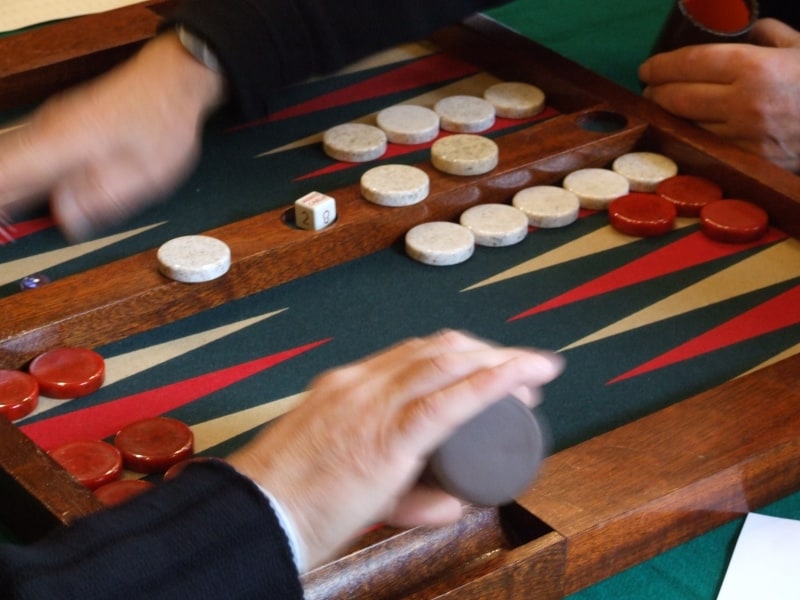
BACKGAMMON
Backgammon is one of the most ancient and most beautiful games existing, and its success is due to the perfect balance between ability and fortune. In a long term match there is nothing to do, the stronger player will be the winner, but in a match with just a few games, a beginner could beat the master. In chess it isn’t possible: this is the main difference between the two games. Playing at Backgammon you will experience loosing against weaker players or winning against stronger players: and if you don’t accept these conditions you will be better off changing game!

All Backgammon players, deep in their heart, think to be better players than they actually are; and this is another secret of the success of this game: the player that won played well and the player that lost was unlucky. Cast the first stone if you never had this kind of thought!
Jacoby e Crawford wrote in The Backgammon book that the Egyptians, great players, never complained about their bad luck, and quoting George Mabardi, they added: «they firmly thought that luck is simply a reward for ability». I agree. The best players are or seem to be the luckiest ones! The fact is that in Backgammon the ability consists mostly in the statistical optimization of someone’s own chances: that is to manage that among all the possible combinations of dice, the majority is to someone’s own favour. And if the majority of the possible combinations of dice are favourable, the impression will automatically be that the player is lucky, but that luck has actually been reached through ability.
The history in short
The most far-off origins of Backgammon go back up to the egyptian boards of Senet, dated 3000 b.C. and after. Fivethousand years of history. But it is only thanks to recent studies that many connections between games have been proved: from Senet, to the Game of Ur of the Sumer tombs, until getting to the games played twothousand years ago by the Romans, such as Alea, Tabula and Ludus Duodecim Scriptorum, certainly connected to our Backgammon. Les jeux sont faits.
A few Centuries after, in Byzantium, also the Eastern Emperor Zeno plays the game called Tabula: one of his unlucky dice rollings has even been described in an epigram by Agathias.
A game directly related with Backgammon is Nard, that from Persia spreads in Middle East and in Asia. The technical description found in the indian text Manasollasa is extraordinarily precise. From India the game travels to China, where it becomes popular during the second half of the First Century, and in Japan, where it is called Sugoroku. The game is played in Greece, but the real diffusion begins after the return of the Crusaders.
During the Middle Age, mantaining the name Tabula, it becomes one of the favourite hobbies of the upper-class, in spite of a long series of prohibitions, most of them arosen from the Church.
Also the book Libros de los Juegos published in 1283 by Alfonso X, named “El Sabio”, king of Castile and Leòn, describes the different kinds of Tablas.
Even though the rules are well known since many centuries, the first time that the word Backgammon is registered is in 1645 (Oxford universal dictionary) and there are different hypothesis to explain its meaning. One is back meaning backwards plus gamen meaning game in medieval english, with a clear reference to the pawns that sometimes have to start over from the beginning. Another refers to the fact that the game was often found at the back of chessboards. One last hypothesis, probably the least trustworthy, refers to the Welsh words bach (small) and cammon (war). In France a variation of the game is called Trictrac, maybe because of the sound provocated by the dice rolling on the wooden board: it has a great success especially during the XVIII Century among the people of the royal court.
In Italy the game is also called Sbaraglino and Tavola reale.
In the XVIII Century the game is common in Europe, as Giacomo Casanova in his Storia della mia vita proves: «he told me that he was living from the game tric-trac although he wasn’t too lucky with dice, because in that game ability counts much more than luck».
At the end of the XIX Century the game almost disappears, starting to spread again only in the beginning of the 70’s, during the XX Century, thanks to two different channels: on one side the United States that in the 20’s, with the doubling dice, made one of the last important changes making the game closer to the one that we play today; on the other side the countries of the Eastern Mediterranean, where it still is very common under the name of Tavli and is played by every social class.

